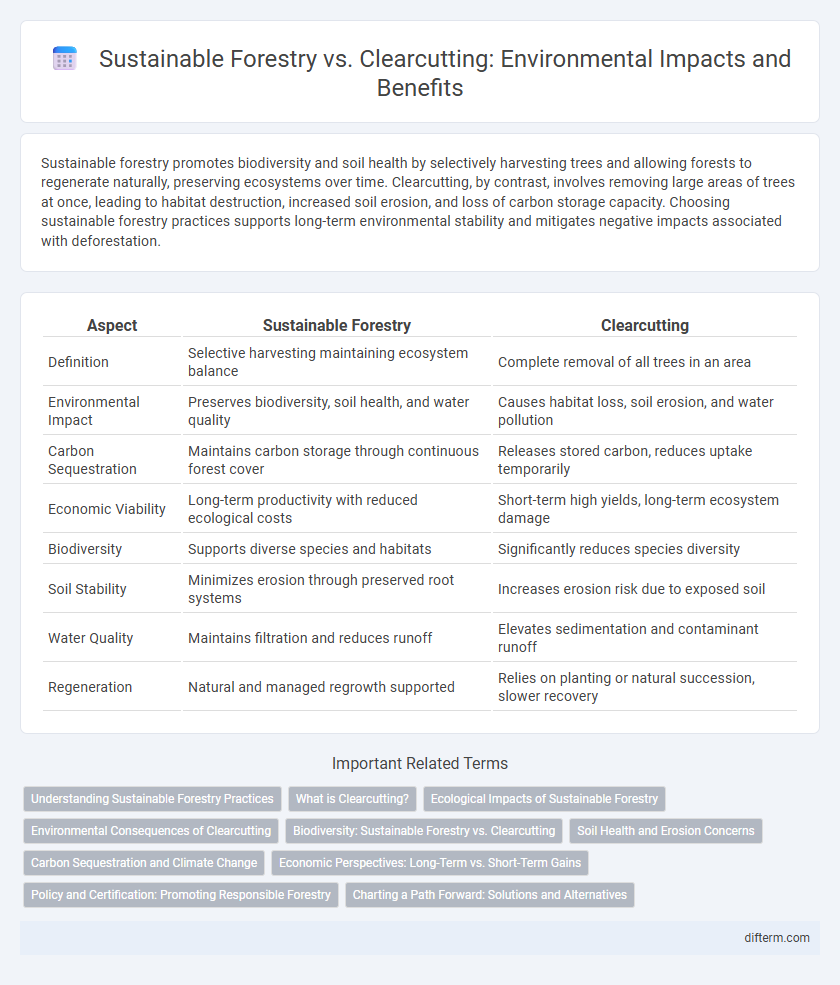Sustainable forestry promotes biodiversity and soil health by selectively harvesting trees and allowing forests to regenerate naturally, preserving ecosystems over time. Clearcutting, by contrast, involves removing large areas of trees at once, leading to habitat destruction, increased soil erosion, and loss of carbon storage capacity. Choosing sustainable forestry practices supports long-term environmental stability and mitigates negative impacts associated with deforestation.
Table of Comparison
| Aspect | Sustainable Forestry | Clearcutting |
|---|---|---|
| Definition | Selective harvesting maintaining ecosystem balance | Complete removal of all trees in an area |
| Environmental Impact | Preserves biodiversity, soil health, and water quality | Causes habitat loss, soil erosion, and water pollution |
| Carbon Sequestration | Maintains carbon storage through continuous forest cover | Releases stored carbon, reduces uptake temporarily |
| Economic Viability | Long-term productivity with reduced ecological costs | Short-term high yields, long-term ecosystem damage |
| Biodiversity | Supports diverse species and habitats | Significantly reduces species diversity |
| Soil Stability | Minimizes erosion through preserved root systems | Increases erosion risk due to exposed soil |
| Water Quality | Maintains filtration and reduces runoff | Elevates sedimentation and contaminant runoff |
| Regeneration | Natural and managed regrowth supported | Relies on planting or natural succession, slower recovery |
Understanding Sustainable Forestry Practices
Sustainable forestry practices prioritize maintaining biodiversity, protecting soil quality, and ensuring long-term forest health by selectively harvesting trees and promoting natural regeneration. These methods contrast sharply with clearcutting, which involves removing all trees in an area, leading to habitat loss, increased erosion, and reduced carbon sequestration. Adopting sustainable forestry supports ecosystem resilience and contributes to climate change mitigation by preserving forest structure and function.
What is Clearcutting?
Clearcutting is a forestry practice involving the complete removal of all trees in a designated area, resulting in a clear, open space that exposes soil and disrupts natural habitats. This method can lead to increased soil erosion, loss of biodiversity, and altered water cycles, making it a controversial approach compared to sustainable forestry techniques. Sustainable forestry, by contrast, emphasizes selective harvesting and forest regeneration to maintain ecological balance and long-term forest health.
Ecological Impacts of Sustainable Forestry
Sustainable forestry preserves biodiversity by maintaining diverse habitats, supporting soil health, and protecting water quality, unlike clearcutting which often leads to habitat loss and increased erosion. It fosters long-term forest resilience by promoting natural regeneration and minimizing disruption to ecosystem processes. This approach also reduces carbon emissions by retaining forest cover and enhancing carbon sequestration.
Environmental Consequences of Clearcutting
Clearcutting causes severe soil erosion, disrupts water cycles, and destroys habitats, leading to significant biodiversity loss. The removal of all trees in an area decreases carbon sequestration, contributing to higher atmospheric CO2 levels and accelerating climate change. This practice also destabilizes local ecosystems, increasing vulnerability to invasive species and reducing long-term forest productivity.
Biodiversity: Sustainable Forestry vs. Clearcutting
Sustainable forestry practices maintain biodiversity by preserving diverse tree species, habitats, and wildlife corridors, fostering ecosystem resilience and stability. Clearcutting drastically reduces habitat complexity, leading to significant losses in plant and animal species and disrupting ecological balance. Long-term biodiversity conservation relies on sustainable forest management that mimics natural disturbances while minimizing environmental impact.
Soil Health and Erosion Concerns
Sustainable forestry practices prioritize maintaining soil structure and nutrient balance, which preserves soil health and reduces erosion risks. In contrast, clearcutting exposes soil to direct sunlight and heavy rainfall, increasing runoff and accelerating erosion rates. Maintaining continuous forest cover under sustainable methods supports microbial activity and organic matter retention critical for long-term soil fertility.
Carbon Sequestration and Climate Change
Sustainable forestry promotes continuous carbon sequestration by maintaining forest cover and enhancing biodiversity, which helps mitigate climate change. Clearcutting drastically reduces the forest's capacity to store carbon, releasing large amounts of CO2 and accelerating global warming. Practices like selective logging and reforestation in sustainable forestry support long-term carbon storage and ecosystem resilience.
Economic Perspectives: Long-Term vs. Short-Term Gains
Sustainable forestry promotes long-term economic stability by maintaining forest productivity, biodiversity, and ecosystem services that support industries such as timber, tourism, and recreation over time. Clearcutting yields immediate financial returns through rapid timber extraction but often leads to soil degradation, reduced wildlife habitat, and regeneration costs that can undermine future economic benefits. Investing in sustainable practices can enhance forest resilience and ensure continuous revenue streams, while reliance on clearcutting risks economic losses from environmental degradation and resource depletion.
Policy and Certification: Promoting Responsible Forestry
Sustainable forestry policies emphasize selective logging and ecosystem preservation, supported by certification programs like FSC and PEFC that enforce strict environmental and social standards. These certifications promote responsible forestry by ensuring transparency, traceability, and community engagement, reducing the negative impacts associated with clearcutting practices. Government regulations combined with market-driven certification systems incentivize sustainable forest management and conserve biodiversity.
Charting a Path Forward: Solutions and Alternatives
Sustainable forestry practices prioritize ecosystem health, biodiversity preservation, and long-term timber availability, contrasting sharply with clearcutting's extensive habitat disruption and soil degradation. Techniques such as selective logging, agroforestry, and extended rotation periods enhance forest resilience and carbon sequestration capacity. Policy frameworks promoting certification standards like FSC and incentives for reforestation projects play crucial roles in transitioning towards sustainable forest management.
sustainable forestry vs clearcutting Infographic

 difterm.com
difterm.com